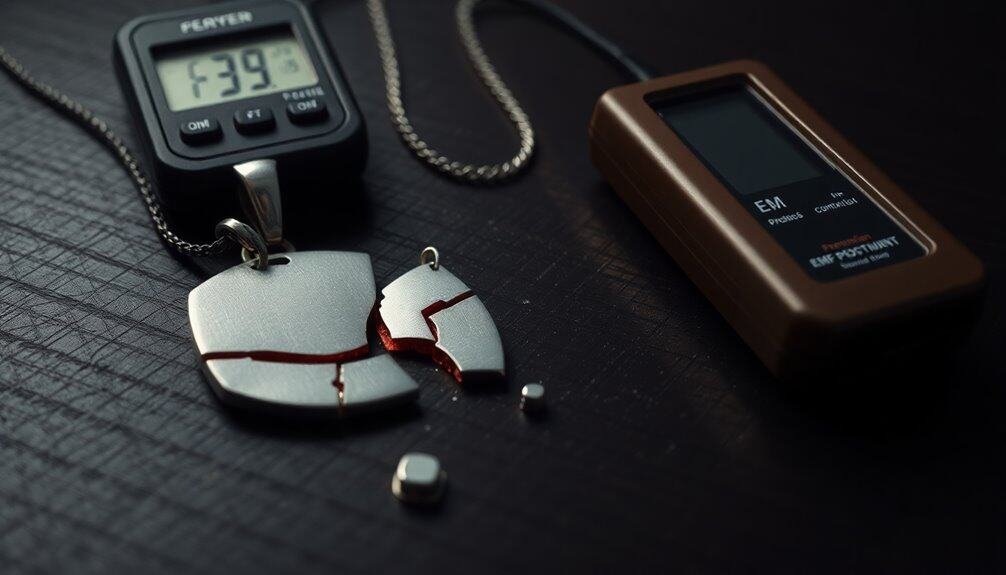Limitations of EMF Protection Devices

EMF protection devices face limitations due to limited scientific evidence supporting their effectiveness, variable performance of materials like copper across frequencies, and inflexibility in heavy shielding that requires precise placement. Inconsistent regulatory standards further complicate the assessment of health benefits.
Ongoing research seeks to enhance shielding materials, which may eventually clarify their effectiveness. Understanding these insights can deepen your knowledge of EMF protection devices.
Disclaimer: As an affiliate, I may collect a share of sales from the links on this page.
Efficacy Concerns of EMF Protection Devices

While many consumers seek EMF protection devices to mitigate potential risks associated with electromagnetic fields, the scientific evidence supporting their efficacy remains limited.
Most research shows variable methodologies, making comparisons difficult. Additionally, some apparent benefits may result from the placebo effect rather than actual device functionality. Prolonged exposure to EMFs can lead to serious health problems, including increased risk of cancer, which adds urgency to finding effective solutions.
There’s a lack of standardized testing, leading to inconsistent results across studies. Furthermore, small sample sizes and short durations hinder the generalizability of findings.
Without control groups, it’s challenging to establish baseline comparisons, creating uncertainty around the true effectiveness of these devices in limiting EMF exposure and its associated health risks. Moreover, extensive permanent shielding can potentially lead to unintended consequences for health, heightening concerns about the protective efficacy of these devices and their impact on natural EMFs.
Material Selection and Frequency Dependence
Selecting the right materials for EMF protection is essential for effective shielding. High conductivity materials, like copper and silver, vary in effectiveness based on purity and thickness. Heavy materials generally provide better shielding but compromise flexibility and comfort. Each material’s effectiveness differs across frequency ranges, meaning specific selections are important for ideal protection. Additionally, fabrics with 20%+ metallic fibers can achieve up to 99.99% effectiveness at certain frequencies. Combining materials enhances coverage but increases complexity. Conductive fabrics offer lightweight options, though they may have lower shielding effectiveness. Additionally, corrosion resistance is critical for durability. Challenges include sourcing quality materials and ensuring proper placement to avoid gaps that could expose you to EMF interference. Understanding the interaction mechanisms of EM waves with these materials is vital for improving protective performance.
Health Effects Attributed to EMF Exposure

Research has identified various health effects linked to electromagnetic field (EMF) exposure, raising questions about safety. Some studies suggest you may experience increased stress and anxiety. Cognitive impairment, including memory issues, has also been reported. Additionally, EMF can induce oxidative stress, affecting tissue health. Symptoms like fatigue and headaches are frequently associated with exposure. Significantly, children’s nervous systems seem more vulnerable to these effects. While biological impacts exist, not all are classified as health hazards. EMF disrupts tissue chemical structures and ongoing research into the cumulative effects of prolonged exposure continues, but consistent evidence of adverse health impacts remains inconclusive across multiple studies. Importantly, electric blankets expose users to higher levels of EMF radiation, particularly when used for prolonged periods.
Regulatory and Safety Standards
As electromagnetic field (EMF) technology advances, regulatory bodies establish safety standards to protect public health.
The FDA offers guidance on electromagnetic compatibility (EMC) testing for medical devices, ensuring they don’t interfere with other equipment. The FCC sets radio frequency limits for devices, aligning with ANSI/IEEE standards.
ICNIRP provides exposure guidelines, while the Department of Defense outlines procedures for EMF hazard control.
Devices must pass conformity assessments, adhering to Specific Absorption Rate (SAR) limits. Non-compliant devices risk penalties, and global harmonization efforts aim to unify standards, ensuring consistent safety measures across borders for effective EMF exposure management.
Future Research Directions for EMF Protection

Emerging technologies promise to reshape the landscape of electromagnetic field (EMF) protection. Researchers are exploring advanced materials like metamaterials to improve shielding effectiveness.
Smart fabrics that block EMFs will enhance comfort for wearables. Nano-technology enables the creation of thinner, efficient shielding materials, while biodegradable options reduce environmental impacts.
Conductive coatings can amplify EMF shielding performance. Additionally, wearable devices could simultaneously monitor and protect against exposure.
Smart home systems may integrate protection features, and industrial shielding solutions target high EMF environments. Ongoing research into the biological impacts of EMF exposure guarantees thorough protection, balancing technological advancements with health considerations.
Frequently Asked Questions
Can EMF Protection Devices Be Harmful to Health?
EMF protection devices typically aren’t harmful to health, but they can lead to misplaced trust. When you rely on unproven devices, you might ignore effective health measures, creating unnecessary stress and potential financial strain.
How Can I Assess the Quality of EMF Protection Devices?
To assess EMF protection devices, check their materials, frequency range, and user reviews. Look for certification from recognized bodies, guarantee compliance with regulations, and compare manufacturer claims with independent test results for effectiveness.
Are There Any Alternatives to EMF Protection Devices?
Yes, you can explore alternatives like reducing device usage, optimizing placement, or creating EMF-friendly environments. Techniques like natural resonance or engaging in further scientific studies can enhance your understanding and management of EMF exposure effectively.
How Do I Choose the Right Shielding Material?
Like choosing a knight’s armor, you’ll want to assess each shielding material’s conductivity, weight, flexibility, and resistance to corrosion. Consider your application’s needs, balancing cost and durability to find the perfect fit for your situation.
What Are Common Misconceptions About EMF Protection Devices?
You might think EMF protection devices block all radiation, but that’s misleading. Many claims lack scientific backing, and their effectiveness varies considerably. Consumer misconceptions often lead to unrealistic expectations about safety and health benefits.
Conclusion
EMF protection devices have significant limitations in their effectiveness and material composition. Most studies suggest minimal health benefits for the average person, despite increasing EMF exposure concerns.
Regulatory standards for these devices are inconsistent, complicating the validity of their claims. Future research should focus on scientifically robust methodologies to address these issues.
Understanding these limitations enables informed decisions about EMF protection, rather than relying on market-driven narratives. Stay educated and critically evaluate your options.



